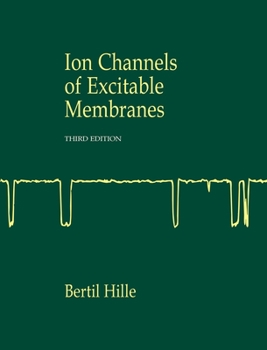Ion Channels of Excitable Membranes
Ion channels underlie a broad range of the most basic biological processes, from excitation and signaling to secretion and absorption. Like enzymes, they are diverse and ubiquitous macromolecular catalysts with high substrate specificity and subject to strong regulation. This fully revised and expanded third edition of Ion Channels of Excitable Membranes describes the known channels and their physiological functions, then develops the conceptual background...
Format:Hardcover
Language:English
ISBN:0878933212
ISBN13:9780878933211
Release Date:July 2001
Publisher:Sinauer Associates Is an Imprint of Oxford Un
Length:816 Pages
Weight:3.43 lbs.
Dimensions:1.4" x 8.0" x 9.5"
Customer Reviews
5 ratings
Keeps getting better with each Edition
Published by Thriftbooks.com User , 22 years ago
This book is a must-have for anyone working with excitable cells, be they experimentalists or modelers. It's a great reference book; everything is clearly indexed and almost compulsively cited. I've been using this book since its first edition, and it just keeps getting better each time.
Rara avis
Published by Thriftbooks.com User , 22 years ago
This classic deserves all the praise it gets. It is an excellent introduction to the molecular biology of channels, told with an eye to history as well as science.
A classic. Still authoritative.
Published by Thriftbooks.com User , 22 years ago
This is an authoritative textbook on ion channels that is often quoted in numerous textbooks in neurophysiology. Hille himself has contributed a lot in this field. The Hogkin-Huxley model is the de facto standard model in neurophysiology but certain things about neurons cannot be explained only with voltage-controlled sodium and potassium channels. With the patch-clamp technique, we have found a way to explore other interesting channles. To remind you, there are a world of ion channels! Hille's textbook show there are indeed a variety of channels most of which are poorly understood. As a reviewer below has commented, it also gives a unique insight into the history of neural membrane research. Concepts are explained with clearity. Details measurement techniques.
Why we visualize ion channels as distinct entities
Published by Thriftbooks.com User , 23 years ago
There are new books on this subject, but they are not as strong on fundamentals as this classic.One of the surprises in this splendid, fascinating book arises from Hille's thumbnail history of the very idea of individual ion channels. It is a much more recent idea than I realized. Not until the mid-1960s did neurophysiologists finally arrive at the now commonplace image of an ion channel as an individual structure - an ion-specific porthole or passageway through the cell membrane. Hille emphatically characterizes the individual channel as "a discrete entity," and as "a distinct molecule." By 1965 this concept had been in the air for a while, but it did not prevail or become the dominant picture until binding studies were conducted with tetrodotoxin and saxitoxin. Largely thanks to this work, by the late 1960s, the author recounts, the names "Na Channel" and "K Channel" began to be used consistently. The familiar picture of individual channels embedded in the cell membrane was brought to us by the magic of long division. For example, "Dividing specific binding by membrane area yields an average saxitoxin receptor density of 110 sites per square micrometer on the axon membranes of the vagus. We now know that the tetrodotoxin-saxitoxin receptor is a single site on the Na channel, so this experiment tells us how many Na channels there are in the membrane. Surface densities of 100 to 400 channels per square micron are typical ..." The picture you get is one of barrel like protein ports floating like buoys in the membrane, nicely regimented into rows and columns, neatly anchored at the intersection points of an imaginary grid. It is, of course, an image made ideal by the arithmetic which originally produced it. Hille concludes: "Now that we can record from single channels - and even purify the chemically, and sequence and modify their genes - there remains no question of their molecular individuality. Well, it is in some sense just a semantic matter, but a few observers, of whom I am one, think there remains after all a colossal, towering, staggeringly important question about the molecular "individuality" of these passages. This is because they can be structurally and functionally linked. Linked receptors are a commonplace of biochemistry. Extensive linkage between ion channels in nerves would open up some very nice possibilities, explain many mysteries, etc. Is there any evidence for linked or complex ion receptors? At the end of Chapter 5, in a literature summary, the author remarks on the then newly discovered double barreled anionic channels, and notes some Cl channel electrophysiological data that seem to make it look "as though the channel were a cluster of pores - like a sieve or an aggregate of straws. An alternative would be that the pore fluctuates through frequent rearrangements of many constituent parts." This is precisely the type of liberated thinking that could get us somewhere fast. If you put two pulls on an ordinary z
Concise text from the first expert in the field
Published by Thriftbooks.com User , 24 years ago
Excellent collection of essays about biophysics of ion channels. Concise, easy to understood, the same time not oversymplified, text from the first rank scientist. The book is suitable for biophysicist and molecular and cellular neuroscientists, although for the last, the book which cover a genetic and cellular components of channel signalling is needed also. The book is also suitable for reader whose knowledge in physics and chemistry is far from beeing the best - the author will remind you the basics in physics and thermodynamics in user friendly and "understoodable" manner.




